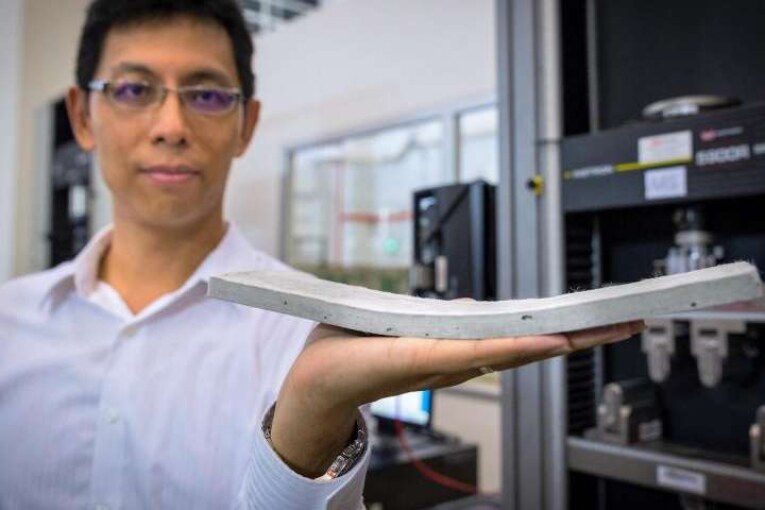
Introduction
- It is a special type of concrete that can take the bending stresses. It consist of special type of materials that makes it flexible. It was developed by the professor victor Li at the University of Michigan.
- A new type of fibre reinforced bendable concrete is used in various places.
- Traditional concrete is a very brittle material; any buckling or bending will cause it to crack. A new type of fiber-reinforced bendable concrete might just be putting an end to that issue.
- This new concrete around 500 times more resistant to cracking than regular concrete thanks to the fibers, which account for two cracking than regular concrete thanks to the tiny fibers.
- The fibers slide within the concrete when bending occurs, providing it with enough give to prevent breakage.
- Capable of exhibiting considerably enhanced flexibility.
Ingredients of ECC
- Fibers reinforcement
- Slick coating (anti-friction coating)
- Fine sand
- Super plasticizer
What is ECC?
- It is a class of ultra-ductile fibre reinforced cementitious composites characterized by high ductility and tight crack width control.
- Engineered Cementitious Composite (ECC), also called bendable concrete, is an easily molded mortar based composite reinforced with specially selected short random fibers, usually polymer fibers.
- ECC has a strain capacity in the range of 3 to 7% compared to 0.01% for ordinary Portland cement (OPC). ECC therefore acts more like a ductile than a brittle.
Why ECC?
- Conventional concretes are almost unbendable and have a strain capacity of only 0.1% and are highly brittle and rigid.
- An ECC has a strain capacity of more than 3% and thus acts more like a ductile metal rather than like a brittle glass.
Composition of ECC
- Bendable concrete is composed of all the ingredients of a traditional concrete minus coarse aggregates and is reinforced with polymer fibres.
- It contains cement, sand, water, fibres, and admixtures.
- Polyvinyl Alcohol-fibres covered with a very thin, slick coating which prevents the fibre from rupturing. Thus ECC deforms much more than a normal concrete but without fracturing.
Working Mechanism
- Whenever the load increases beyond its limiting value the strong molecular bond formed between PVA fibres and concrete during hydration prevents it from cracking.
- Different ingredients of ECC work together, to share the applied load.
Scope of Bendable Concrete
- Traditional concrete is considered to be a ceramic, brittle and rigid.
- It can suffer catastrophic failure when strained in an earthquake or by routine overuse.
- ECC acts more like metal than glass.
- It is studded with specially-coated reinforcing fibers that hold it together.
- Traditional concrete fractures and can’t carry a load at 0.01% tensile strain.
Environment Friendliness
- ECC incorporates high volumes of industrial wastes including fly ash, sands and wastes from metal casting processes, waster cement kiln dust from cement production.
- ECC is a green construction material.
- Reduce emission of Greenhouse production.
- ECC is 37% less expensive, consumes 40% less energy, and produces 39% less carbon dioxide than regular concrete.
Advantages of Bendable Concrete
- The flexible concrete has the ability to bend like a metal.
- It is more stronger, more durable, and lasts longer than conventional concrete.
- In the construction resistant structure.
- It is not brittle like a glass.
- It does not emit that amount of harmful gases as compared to conventional concrete.
- In flexible concrete roads and bridges there is no need of joint as the ECC itself has the ability to change its shape.
- The flexible concrete is approx 20-40% percent lighter.
- It reduces the cost of the project.
- It can be used as precast concrete.
Disadvantages of Bendable Concrete
- It has a high initial cost as compared to conventional concrete.
- It requires skilled labor for its construction.
- It needs some special type of materials which can be difficult to find in some areas.
- Its quality depend upon the material used and the condition under which it is made.
- Its compressive strength can be lesser than the conventional concrete.
Applications
- In the construction of the joint less bridges.
- In Earthquake resistant structures.
- In flexible concrete roads and bridges there is no need of joint as the ECC itself has the ability to change its shape.
- ECC overlays can be used over cracked concrete surfaces.
Conclusion
- ECC is the upcoming advancement in technology which will almost replace the conventional concrete in countries which are more prone to Natural disaster.
- But in India it is still a new material and requires proper research for its use in India.



Where can I buy the slick coating and the fibres?